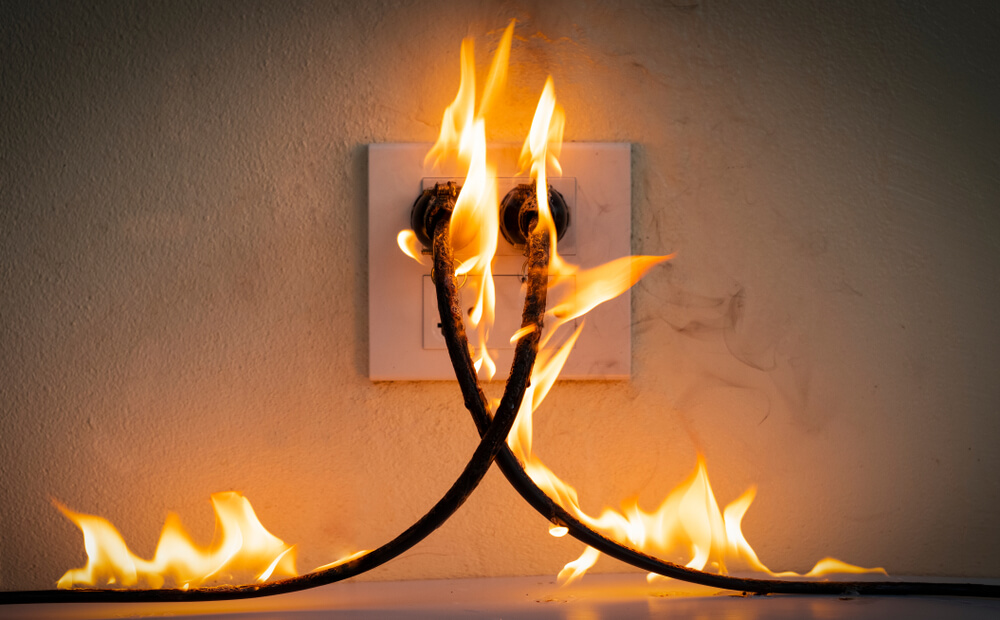Few things are as hazardous as an electrical fire in a home or business premises. Unfortunately, electrical fires can start spontaneously at any time and spread quickly. Not only do electrical fires threaten the lives of building occupants and people in the surrounding area, but they can also entirely destroy property in a very short period of time.
Luckily there is plenty that homeowners, premises managers and landlords can do to minimise the risk of a devastating electrical fire breaking out on their premises. In this article, we explain how electrical fires start and what may cause them. We also consider how to prevent electrical fires and how best to tackle an electrical fire should one start.
How do electrical fires start?
To start a fire, electrical energy first needs to be converted into heat energy. The conversion of electrical energy to heat occurs when a resistor of some sort is placed in the electrical circuit. At its most basic, a resistor is anything that impedes or interrupts the flow of electricity. In the case of an electrical fire, the resistance is created accidentally, usually due to some sort of fault in the electrical circuit.
The conversion of electrical energy to heat energy at the site of resistance creates the potential for a fire to occur. If the fault is in the open air or surrounded by inflammable material, the heat may be dissipated before the ignition point is reached. Unfortunately, if the heat build-up is in an enclosed space, or builds up next to timber, upholstery or some other flammable material, there is the chance of surrounding material catching fire.
Another way in which electricity can start a fire is if an arc is accidentally created. An electrical arc is caused when electricity travels down an unintended path. Arcing can cause sparks that have the potential to start an electrical fire.
Causes of electrical fires
Electrical circuitry and appliances are designed to minimise the risk of arcing or a build-up of electricity. In well-maintained, correctly installed electrical equipment and circuitry several safeguards are put in place. These include the installation of circuit breakers and fuses, and the covering of electrical wiring with an insulating sheath and earthing appliances to prevent them from becoming live in the event of a circuit malfunction. Faults in appliances and circuitry, either due to poor installation, wear and tear or malfunction, can all increase the risk of an electrical fire.
Some of the commonest faults to be aware of are detailed below.
- Wiring without an insulating sheath or partially frayed wiring.
- Outdated wiring or circuit breakers, which can’t safely carry the amount of electricity needed by 21st century building occupants.
- Loose or frayed wiring in sockets or outlets.
- Overuse of extension leads increases the risk of overloading, which in turn may lead to arcing.
- Wiring that has been interrupted by a metal nail or staple.
- Older appliances that may have faulty wiring or other defects.
It’s not just defects in circuitry and/or appliances that may cause an electrical fire – the surrounding environment can also play a key role in determining if an electrical fire will occur. If electrical wiring is exposed to water, for example, or is exposed to extreme heat, the risk of an electrical fire increases significantly. This is why boilers and hot water heaters require particular vigilance when it comes to safety inspections and maintenance. When wiring is surrounded by flammable material the risk of an electrical fire should a malfunction occur escalates. Note that periods of dry, hot weather can remove moisture from a building, increasing the risk of widespread fire should an electrical fault occur.
Preventing electrical fires
- Ensure that the wiring, motherboard, circuit breakers and other components of the electrical circuitry in your building are inspected and tested by a qualified electrician every five years or so.
- Only use a qualified, licensed electrician for your electrical installation, repair and maintenance work.
- Make sure appliances are used in line with the manufacturer’s instructions. In particular, don’t run appliances for long periods of time (such as overnight) unless they are designed for this.
- Fit smoke alarms and ensure they’re correctly maintained.
- Use the right fuse for the appliance.
- In commercial premises, make sure that small appliances are tested and tagged.
- If you notice any signs that an electrical appliance or circuit may need attention (such as sparks, intermittent failure, a smell of burning, frequent shorting out or the appliance growing warm), disconnect the power supply and obtain professional assistance.
How to put out an electrical fire
If you discover an electrical fire, sound the alarm and make sure other building occupants leave. For all but the smallest of electrical fires, call the emergency services. Electrical fires are dangerous and frequently require professional control.
When an electrical fire has broken out, the electricity feeds it. If it is safe to do so, cutting off the supply of electricity, either by unplugging an appliance or switching the power off at the mains is the first step in putting out the fire. A fire needs fuel and oxygen to be sustained. If you’ve cut off the power (fuel), the next thing to do is, if it’s possible to do so safely, deprive the fire of oxygen. Throwing a fire blanket over a burning electrical appliance, for example, or covering the fire with an appropriate retardant from a fire extinguisher intended for electrical fires may be enough to extinguish the flames.
DO NOT USE WATER TO PUT OUT AN ELECTRICAL FIRE. Water is an electrical conductor. If the current is still flowing and the electricity connects with the water, it can pass through it, potentially causing an electric shock or worse.
What fire extinguisher is used for electrical fires?
Class E fire extinguishers are the only type of extinguisher that should be used on electrical fires. Class E extinguishers contain carbon dioxide. The high concentration of carbon dioxide that the extinguisher delivers displaces the oxygen from the air surrounding the fire. Without oxygen, the fire can’t thrive. Whilst Class E extinguishers can be used on fires started in other ways, no other type of extinguisher is suitable for an electrical fire.
Contact Oceanside Services
With the correct preventative measures, it’s possible to keep the risk of an electrical fire extremely low. Oceanside Services provides professional electrical maintenance, inspection and repair services that ensure your appliances and wiring are all in a good, safe condition.



 5 Star Service
5 Star Service 






